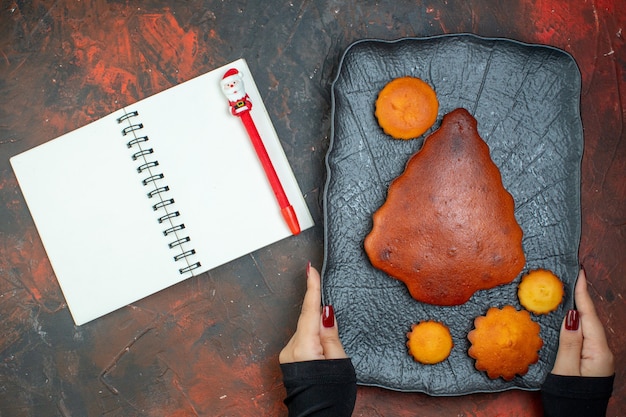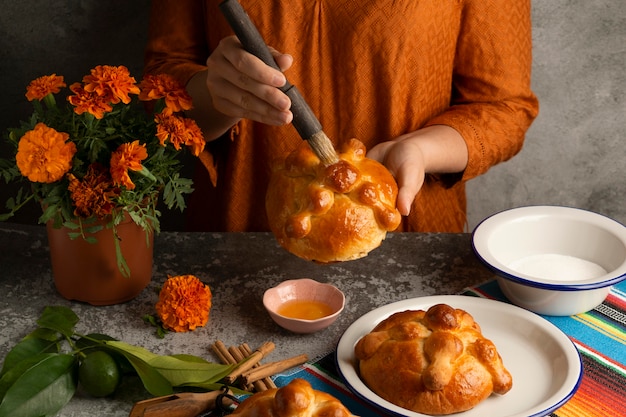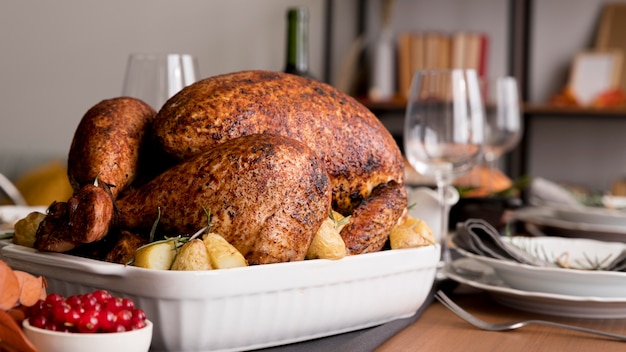Alright, folks, let's talk turkey! I'm not talking about the bird-brained conversations you might have around the dinner table, but rather, the real deal – a majestic, juicy, 26-pound turkey ready to grace your table. You know, the kind that's a real showstopper, especially for those special occasions. Now, while I'm no culinary maestro, I've learned a thing or two about roasting a turkey over the years, and I'm here to share all my secrets with you. From picking the perfect bird to carving it like a seasoned pro, we'll cover it all. So, grab your apron, put on your comfy shoes (this is a marathon, not a sprint!), and let's get this turkey roasting!
(Part 1) Choosing Your Bird: The Foundation of a Delicious Feast

First things first, you need the main attraction. Choosing the right turkey is like picking the perfect partner for a dance – it sets the tone for the entire experience. While size matters (we're dealing with a hefty 26-pounder here!), it's not the only thing to consider. I'm a firm believer in fresh, not frozen. The flavor just sings a different tune, and you can see if the skin is plump and healthy, a good sign of a well-raised bird.
Essential Turkey Selection Tips: Making the Right Choice
Here are a few key points to keep in mind when selecting your turkey:
- Fresh or Frozen: Fresh turkeys are my personal preference, mainly because the flavor is richer and the texture more appealing. However, if you're short on time or haven't planned ahead, frozen turkeys work just fine. Just be sure to thaw them properly before cooking.
- Size Matters: A 26-pound turkey is a big commitment! It's going to feed a crowd (think 15-20 people), so make sure you have enough hungry guests to polish it off. And, of course, ensure you have a roasting pan big enough to accommodate this magnificent bird.
- Weight to Serving Ratio: It's good to have a rough idea of how much turkey you'll need. A 26-pound turkey is perfect for a large gathering, but if you're cooking for a smaller crowd, you might want to scale down. Don't worry about leftovers, though – turkey sandwiches are a delicious way to utilize those extra bits.
- Brand Loyalty: There's no need to reinvent the wheel. I've always had good luck with Butterball turkeys. They're reliable, plump, and the skin is thicker, which helps to create a crispy masterpiece.
(Part 2) Preparing Your Turkey: Getting Ready for the Oven

You've got your turkey, now it's time to prep it! This stage is like getting ready for a big event – a little attention to detail makes a world of difference. The key is to dry the turkey thoroughly, both inside and out. This helps ensure crispy skin and prevents any unwanted bacterial growth.
The Turkey Prep Checklist: A Step-by-Step Guide
Here's how to prep your turkey like a pro:
- Dry It Off: Grab some paper towels and give that bird a good pat down. Get it nice and dry, both inside and out. This is crucial for achieving crispy skin.
- Remove the Neck and Giblets: Most turkeys come with these hidden inside the cavity. These can be used to make a flavorful stock, or you can simply discard them.
- Untrussing: Some turkeys come trussed, with their legs and wings tied together. It's up to you whether to leave the string in, but I find it easier to remove. Just snip it off carefully.
Brining: A Controversial Topic (Optional)
Now, we come to the age-old debate: brining. Some swear by it, claiming it makes the turkey incredibly juicy and flavorful. Others find it unnecessary. Personally, I'm not a brining enthusiast, but if you're a believer, go for it! Just remember to adjust the cooking time accordingly.
- What is Brining? Brining is simply soaking the turkey in a salt-water solution for several hours. This helps retain moisture and keeps the meat tender. You can use a basic salt-water brine or add herbs and spices to enhance the flavor.
- Brining Time: A 26-pound turkey needs to brine for a minimum of 12 hours, but ideally 24 hours. It's a commitment, but some say it's worth it.
- Dry Thoroughly After Brining: After brining, pat the turkey dry again. This ensures the skin crisps up nicely in the oven.
(Part 3) Stuffing: A Beloved Tradition (Optional)

Ah, stuffing – a classic Thanksgiving staple. It's a real comfort food, but it can also be a bit of a culinary gamble. Getting it to cook evenly can be tricky, which is why I prefer to make it separately. If you're determined to stuff your turkey, choose a recipe that calls for pre-cooking the stuffing in the oven or on the stovetop. This ensures it’s safe to eat and cooked to perfection.
Stuffing Tips: Avoiding food safety Issues
If you're going for a stuffed turkey, here are some safety tips to keep in mind:
- Cook the Stuffing First: Always cook the stuffing thoroughly before placing it in the turkey. This is a crucial step to prevent foodborne illness. You can cook it in the oven, on the stovetop, or even in the microwave.
- Don’t Overstuff: Stuff the turkey loosely, don't pack it in. This allows the stuffing to cook evenly. Overstuffing can trap moisture and make the stuffing undercooked.
- Use a meat thermometer: Always check the internal temperature of the stuffing with a meat thermometer. It should reach 165°F (74°C) for safe consumption.
- The Safer Option: The USDA recommends cooking stuffing separately for food safety. It’s always better to err on the side of caution.
(Part 4) Getting Ready to Roast: Setting the Stage for Turkey Perfection
Now, we're getting to the fun part! You've prepped your turkey, maybe even brined and stuffed it, and the oven is ready to work its magic. It's time to roast!
Choosing the Right Roasting Pan: Giving Your Turkey Space to Shine
A 26-pound turkey needs plenty of room to breathe. Make sure you have a large roasting pan, preferably one with a rack. This allows for good air circulation, helping the turkey cook evenly. If you don’t have a roasting pan, a large baking sheet with a rack will also work.
Preheating the Oven: The Crucial First Step
Preheating the oven is crucial – it’s like warming up before a workout. A cold oven can shock the turkey, causing it to cook unevenly. Preheat your oven to 325°F (160°C) to ensure even cooking.
Seasoning Your Turkey: Adding Flavor and Aroma
This is where your creativity shines! There are countless ways to season a turkey. You can go classic with salt, pepper, and herbs, or experiment with spices and citrus zest.
- Classic Seasoning: Salt, pepper, garlic powder, onion powder, paprika, and dried herbs like rosemary, thyme, and sage are always a safe bet.
- Citrus Zest: Lemon and orange zest add a vibrant freshness to the turkey.
- Herbs: Fresh or dried herbs like thyme, rosemary, sage, parsley, and oregano add depth and aroma.
- Spices: Experiment with spices like cumin, coriander, cinnamon, and even a touch of ginger for a more complex flavor profile.
- Butter and Herbs: Rub the turkey with a mixture of butter and herbs for extra moisture and flavor.
(Part 5) roasting time: Bringing Your Turkey to Life
Okay, it's time to put your turkey in the oven! You've prepped it, seasoned it, and the oven is hot and ready. Now it's time to cook it to perfection!
Calculating Roasting Time: A Reliable Guide
A general rule of thumb is to cook a turkey for 15 minutes per pound at 325°F (160°C). For a 26-pound turkey, this means about 6 hours and 30 minutes in the oven. However, it’s always a good idea to check the internal temperature to make sure the turkey is cooked through.
- For a 26-pound turkey: 26 pounds x 15 minutes per pound = 390 minutes (6 hours and 30 minutes).
Roasting the Turkey: The Art of Patience and Attention
Now, let's get this turkey in the oven! Follow these steps:
- Place the Turkey on the Rack: Make sure the rack is in the center of the roasting pan. This ensures even heat distribution, helping the turkey cook evenly.
- Roast the Turkey: Roast the turkey in the preheated oven for the calculated time (approximately 6 hours and 30 minutes).
- Basting: Basting the turkey with its own juices or pan drippings helps to keep it moist and flavorful. Baste the turkey every 30 to 60 minutes during the roasting process.
Checking Doneness: Ensuring a Safe and delicious turkey
This is the moment of truth! You want to make sure the turkey is cooked through, but not dry. Here's how to check:
- Use a Meat Thermometer: The turkey is fully cooked when the internal temperature reaches 165°F (74°C) in the thickest part of the thigh. You can also check the stuffing's internal temperature using a meat thermometer. It should also reach 165°F (74°C).
(Part 6) Resting the Turkey: The Key to Tenderness and Flavor
The turkey is out of the oven, but don’t rush to carve it just yet! The resting period is crucial for allowing the turkey to relax and the juices to redistribute, resulting in a much more succulent and flavorful bird.
Resting Time: Letting the Turkey Relax
Let the turkey rest for at least 30 minutes before carving. You can tent it with foil to keep it warm.
Carving the Turkey: A Culinary Showcase
Here's your chance to shine! carving a turkey is a real art form. Follow these steps to carve your turkey like a pro:
- Transfer to a Cutting Board: Carefully transfer the turkey to a large cutting board.
- Remove the Legs: Use a carving knife to separate the legs from the body. Cut along the joint where the leg meets the thigh, then slice through the skin and meat to separate the legs.
- Remove the Wings: Cut the wings off at the joint where they meet the body, using a carving knife.
- Remove the Breast: Use a carving knife to carve the breast meat. Start at the end of the breastbone and slice down, cutting along the bone. Then, slice the breast meat into thin slices.
- Separate the Thighs from the Drumsticks: Use a carving knife to cut the thighs from the drumsticks at the joint.
- Arrange the Carved Turkey: Arrange the carved turkey on a platter, placing the breast in the center and the legs, thighs, and wings around it.
(Part 7) Making Gravy: Adding the Finishing Touch
What's a roast turkey without a rich, flavorful gravy? It's the perfect complement to the roasted turkey and stuffing, and it’s easy to make using the pan drippings. Trust me, it elevates the entire meal!
Making Gravy: Simple Steps for Flavorful Perfection
Here's how to make delicious turkey gravy:
- Skim the Fat: After removing the turkey from the roasting pan, pour the pan drippings into a fat separator or heat-proof bowl. Skim off the excess fat, leaving behind the flavorful drippings.
- Deglaze the Pan: Add a tablespoon or two of flour to the roasting pan and whisk it around to absorb the drippings. This creates a base for your gravy.
- Make a Roux: Heat the flour mixture over medium heat, stirring constantly, until it turns a light brown color. This is called a roux.
- Add the Drippings: Gradually whisk in the reserved turkey drippings. Bring the mixture to a simmer, stirring constantly, until thickened.
- Season with Salt and Pepper: Season the gravy with salt and pepper to taste.
(Part 8) Serving Your Roasted Turkey: A Moment of Triumph
It's time to celebrate your culinary triumph! The turkey is roasted, carved, and you've got delicious gravy. All that's left is to serve and enjoy!
Serving Suggestions: Creating a Festive Spread
Serve your roasted turkey with all the trimmings to create a truly memorable meal:
- Stuffing: Serve your stuffing alongside the turkey.
- Gravy: Pour gravy over the turkey and stuffing.
- mashed potatoes: A classic side dish that pairs perfectly with turkey.
- Cranberry Sauce: A sweet and tart contrast to the savoury turkey.
- Roasted Vegetables: Add some colorful roasted vegetables to your meal.
(Part 9) Leftovers? No Problem! Turning Turkey into Culinary Magic
The best part about roasting a turkey is the leftovers. There are so many delicious things you can do with them, from sandwiches to salads to soups.
Leftover Turkey Ideas: Getting Creative with Delicious Possibilities
Get creative with your leftovers:
- Turkey Sandwiches: Classic turkey sandwiches are a go-to for a satisfying lunch. Add some lettuce, tomato, and mayonnaise for extra flavor.
- turkey salad: Chop the leftover turkey and mix it with mayonnaise, celery, and onion for a delicious salad.
- turkey soup: Use leftover turkey bones and meat to make a hearty and flavorful soup.
- Turkey Pizza: Top pizza dough with leftover turkey, cheese, and vegetables for a tasty and easy dinner.
- Turkey Enchiladas: Use leftover turkey in a cheesy and flavorful enchilada dish.
FAQs: Answering Your Roasting Questions
1. What if my turkey isn't cooked through?
Don't panic! If your turkey isn't cooked through after the recommended roasting time, simply roast it for another 15 minutes, and check the internal temperature again with a meat thermometer. Make sure the turkey reaches 165°F (74°C) in the thickest part of the thigh.
2. How do I know if the turkey is dry?
A dry turkey can be a real bummer. You can usually tell by looking at the skin. If the skin is wrinkled and leathery, the turkey is probably dry. To prevent dryness, make sure to baste the turkey regularly during the roasting process.
3. Can I freeze leftover turkey?
Absolutely! Leftover turkey can be frozen for up to 3 months. Just wrap it tightly in plastic wrap and aluminum foil, and store it in the freezer. To thaw the turkey, place it in the refrigerator overnight.
4. What if I don't have a meat thermometer?
If you don’t have a meat thermometer, you can check the turkey's doneness by inserting a fork into the thickest part of the thigh. If the juices run clear, the turkey is cooked through. However, a meat thermometer is always the most reliable way to check the turkey's internal temperature.
5. What are some tips for making crispy turkey skin?
crispy turkey skin is the ultimate reward for all your hard work! Here are a few tips to achieve that golden-brown perfection:
- Pat the Turkey Dry: Make sure the turkey is completely dry before roasting. This helps to crisp up the skin.
- Roast at a High Temperature: The higher the temperature, the crispier the skin. Roast the turkey at 325°F (160°C) for the first hour, then reduce the temperature to 300°F (150°C) for the remaining roasting time.
- Don't Overcrowd the Pan: Make sure there’s enough space around the turkey in the roasting pan. This helps the air to circulate and the skin to crisp up.
- Flip the Turkey: Flip the turkey halfway through the roasting process. This helps to cook the skin on both sides evenly.
- Use a Baking Sheet: Place a baking sheet under the roasting pan to catch any drippings. This will help to prevent the skin from becoming soggy.
And there you have it! I hope this comprehensive guide has given you the confidence and knowledge to roast a 26-pound turkey that will impress your guests. Remember, roasting a turkey is a journey, not a race. So relax, enjoy the process, and don't be afraid to experiment. After all, the most delicious turkey is the one you make with passion and a little bit of love.
Everyone is watching

Corn on the Cob: The Ultimate Guide to Perfectly Cooked Ears
Healthy MealsAh, corn on the cob. Just the name evokes images of sunny days, barbecues, and that sweet, juicy flavour that ...

Perfect Pork Roast Oven Cooking Time: A Guide to Delicious Results
Healthy MealsThere's something truly satisfying about a perfectly roasted pork. The aroma alone is enough to make your mout...

Scallops: The Ultimate Guide to Perfect Cooking
Healthy MealsAh, scallops. Those delicate, sweet, and utterly delicious morsels of the sea. They hold a special place in my...

Ham Cooking Time: How Long to Bake, Smoke, or Boil a Delicious Ham
Healthy MealsAh, ham. It's a classic, isn't it? A real crowd-pleaser, especially around holidays. And when done right, it'...

Spaghetti Squash: The Ultimate Guide to Cooking and Serving
Healthy MealsRemember that time you saw spaghetti squash at the supermarket, looking all bumpy and strange, and thought, "W...
